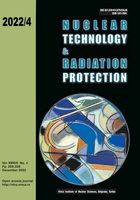
THERMAL-HYDRAULIC ANALYSIS OF LIGHT WATER REACTORS UNDER DIFFERENT STEADY-STATE OPERATING CONDITIONS Part 1 – Boiling Water Reactor

Vol.
XXXVII, No. 4, Pp. 259-339
December 2022
UDC 621.039+614.876:504.06
ISSN 1451-3994
Pages: 259-275
Authors: Ezddin Hutli and Ramadan KridanAbstract
The steady-state thermal-hydraulic analysis of the core of the Boiling Water Reactor (BWR/6) at nominal operating conditions is presented in this paper. The BWR/6 is produced by General Electric USA. The analysis' goal is to keep the thermal safety margin under control and the core integrity intact under steady-state operating conditions. The effects of operating conditions such as power distribution, power level, and coolant mass flow rate on the proposed core's performance are investigated. For this purpose, the one-dimensional computer code MITH was used. The code's reliability was tested using the General Electric benchmark 3579 MW reactor. Two-channel models were tested (the average and the hot channel). Thermal-hydraulic parameters such as fuel-centerline, fuel-surface, outer clad surface and coolant temperature, critical and actual local heat flux, critical and minimum critical heat flux ratio and pressure drop are evaluated along the tested channels. Temperatures, as well as actual and critical heat flux distribution profiles, were obtained. The tested operating conditions had a significant influence on these parameters, and also on the thermal-hydraulic performance. The obtained results are in good agreement with the data from the tested core. The obtained results are well within the safety margins. The good agreement between tested reactor data and MITH code calculation concerning the reactor demonstrates the reliability of the analysis methodology from a thermal-hydraulic perspective.
Key words: fuel, clad, coolant, power, heat flux, minimum critical heat flux ratio
FULL PAPER IN PDF FORMAT (1,81 MB)